Maximilian Engelhardt
Modeling Micro-Doppler Signature of Multi-Propeller Drones in Distributed ISAC
Apr 07, 2025Abstract:Integrated Sensing and Communication (ISAC) will be one key feature of future 6G networks, enabling simultaneous communication and radar sensing. The radar sensing geometry of ISAC will be multistatic since that corresponds to the common distributed structure of a mobile communication network. Within this framework, micro-Doppler analysis plays a vital role in classifying targets based on their micromotions, such as rotating propellers, vibration, or moving limbs. However, research on bistatic micro-Doppler effects, particularly in ISAC systems utilizing OFDM waveforms, remains limited. Existing methods, including electromagnetic simulations often lack scalability for generating the large datasets required to train machine learning algorithms. To address this gap, this work introduces an OFDM-based bistatic micro-Doppler model for multi-propeller drones. The proposed model adapts the classic thin-wire model to include bistatic sensing configuration with an OFDM-like signal. Then, it extends further by incorporating multiple propellers and integrating the reflectivity of the drone's static parts. Measurements were performed to collect ground truth data for verification of the proposed model. Validation results show that the model generates micro-Doppler signatures closely resembling those obtained from measurements, demonstrating its potential as a tool for data generation. In addition, it offers a comprehensive approach to analyzing bistatic micro-Doppler effects.
BIRA: A Spherical Bistatic Reflectivity Measurement System
Jul 18, 2024Abstract:The upcoming 6G mobile communication standard will offer a revolutionary new feature: Integrated sensing and communication (ISAC) reuses mobile communication signals to realize multi-static radar for various applications including localization. Consequently, applied ISAC propagation research necessitates to evolve from classical monostatic radar cross section (RCS) measurement of static targets on to bistatic radar reflectivity characterization of dynamic objects. Here, we introduce our "Bistatic Radar" (BIRA) and antenna measurement facility for bistatic spherical positioning with sub-millimeter accuracy on a diameter of up to 7 m and with almost continuous frequency coverage from 0.7 up to 260 GHz. Currently, BIRA is the only bistatic measurement facility capable of unrestricted ISAC research: In addition to vector network analysis, BIRA employs advanced wideband transceiver technology with an instantaneous bandwidth of up to 4 GHz. These transceivers grant BIRA the unique ability to characterize dynamic targets in both Doppler and range, while also significantly accelerating RCS measurements of static objects.
Accelerating Innovation in 6G Research: Real-Time Capable SDR System Architecture for Rapid Prototyping
Feb 22, 2024



Abstract:The next global mobile communication standard 6G strives to push the technological limits of radio frequency (RF) communication even further than its predecessors: Data rates beyond 100 Gbit/s, RF bandwidths above 1 GHz, and sub-millisecond latency necessitate very high performance development tools to enable the extent of innovation required for 6G's likely features. We propose a new SDR firmware and software architecture designed explicitly to meet these challenging requirements. It relies on Ethernet and commercial off-the-shelf network and server components to maximize flexibility and to reduce costs. We analyze state-of-the-art solutions (USRP X440 and other RFSoC-based systems), derive architectural design goals, explain resulting design decision in detail, and exemplify our architecture's implementation on the XCZU48DR RFSoC. Finally, we prove its performance via measurements and outline how the architecture surpasses the state-of-the-art with respect to sustained RF recording while maintaining high Ethernet bandwidth efficiency. Building a micro-Doppler radar example, we demonstrate its real-time and rapid application development capabilities.
Receiver Bandwidth Extension Beyond Nyquist Using Channel Bonding
Oct 14, 2022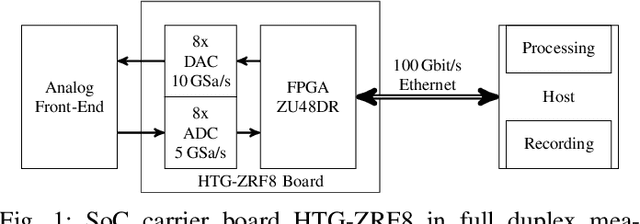

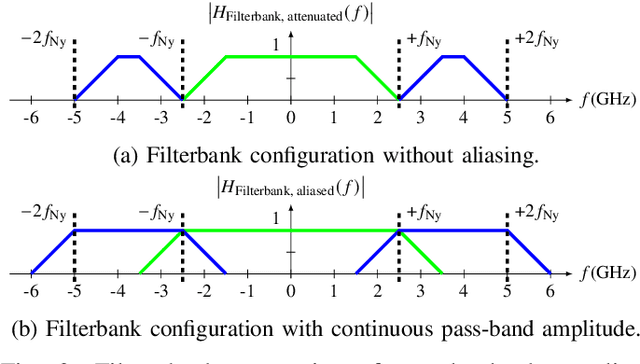
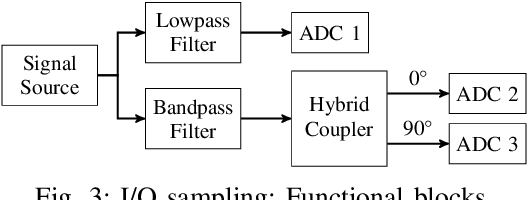
Abstract:Current and upcoming communication and sensing technologies require ever larger bandwidths. Channel bonding can be utilized to extend a receiver's instantaneous bandwidth beyond a single converter's Nyquist limit. Two potential joint front-end and converter design approaches are theoretically introduced, realized and evaluated in this paper. The Xilinx RFSoC platform with its 5 GSa/s analog to digital converters (ADCs) is used to implement both a hybrid coupler based in-phase/quadrature (I/Q) sampling and a time-interleaved sampling approach along with channel bonding. Both realizations are demonstrated to be able to reconstruct instantaneous bandwidths of 5 GHz with up to 49 dB image rejection ratio (IRR) typically within 4 to 8 dB the front-ends' theoretical limits.
Measurement Testbed for Radar and Emitter Localization of UAV at 3.75 GHz
Oct 13, 2022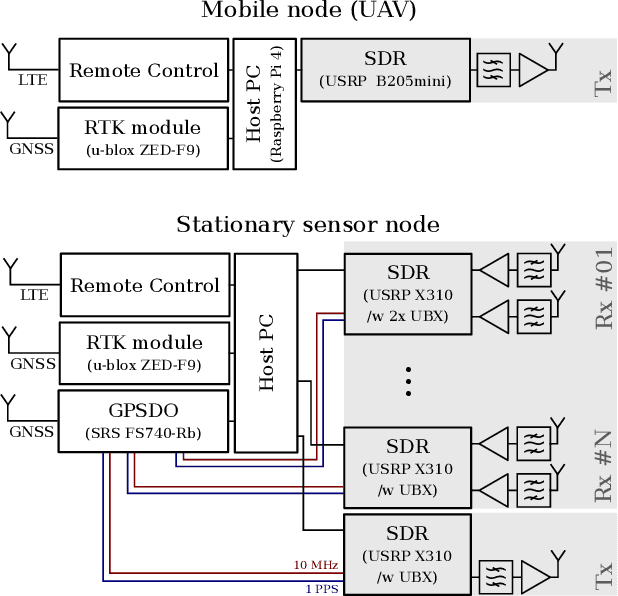
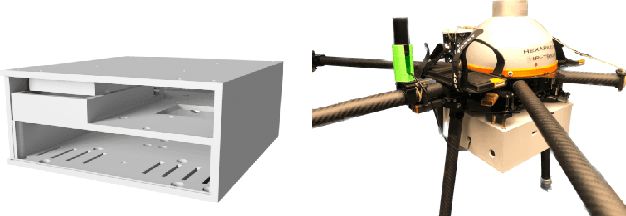
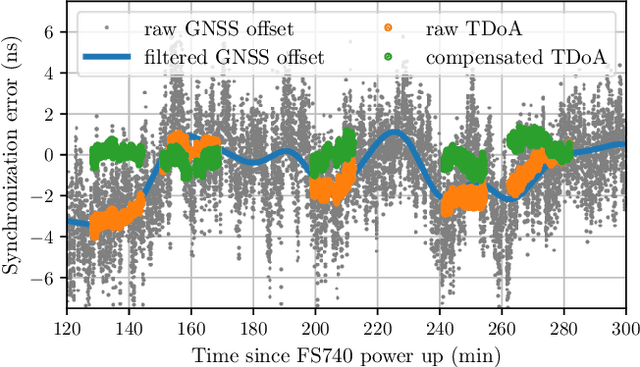
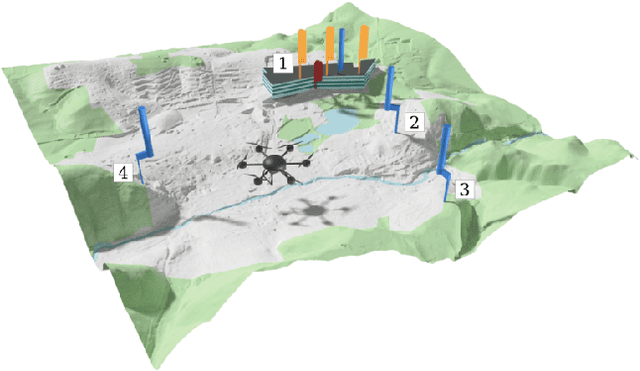
Abstract:This paper presents an experimental measurement platform for the research and development of unmanned aerial vehicles (UAVs) localization algorithms using radio emission and reflectivity. We propose a cost-effective, flexible testbed made from commercial off-the-shelf (COTS) devices to allow academic research regarding the upcoming integration of UAV surveillance in existing mobile radio networks in terms of integrated sensing and communication (ISAC). The system enables nanosecond-level synchronization accuracy and centimeter-level positioning accuracy for multiple distributed sensor nodes and a mobile UAV-mounted node. Results from a real-world measurement in a 16 km2 urban area demonstrate the system's performance with both emitter localization as well as with the radar setup.
Low-Latency Analog-to-Analog Signal Processing using PC Hardware and USRPs
Oct 12, 2022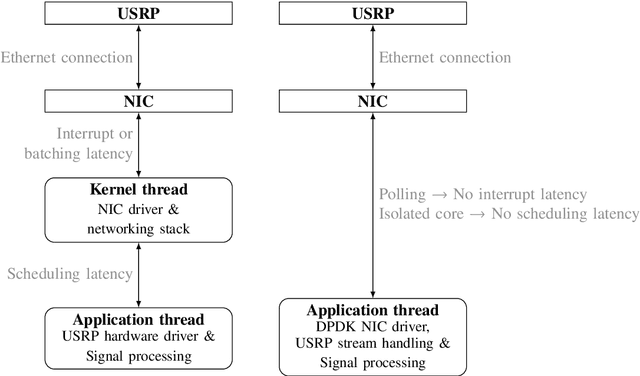

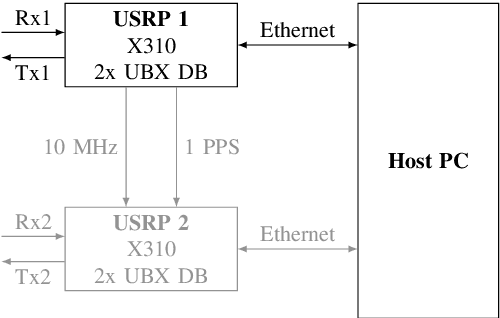
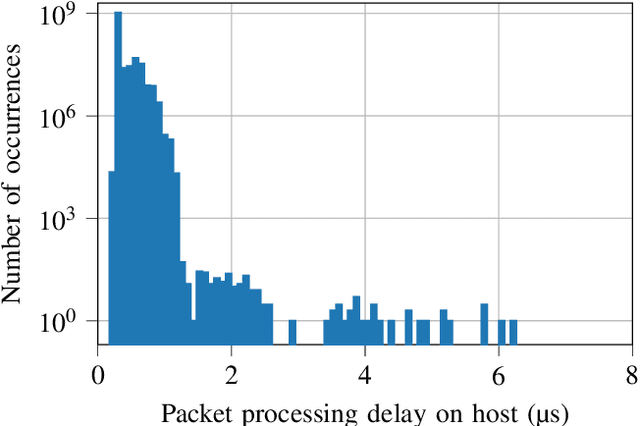
Abstract:In this paper, we implement a low-latency rapid-prototyping platform for signal processing based on software-defined radios (SDRs) and off-the-shelf PC hardware. This platform allows to evaluate a wide variety of algorithms in real-time environments, supporting new developments in the fields of classical, AI-based, and hybrid signal processing. To accomplish this, the streaming protocol of the used USRP X310 devices is implemented using the Data Plane Development Kit (DPDK), which allows to handle network communication in userspace only. This bypasses the kernel and thus avoids the latencies caused by interrupt handling, scheduling, and context switches. It allows signal processing to be performed on isolated processor cores that are protected from interrupts to a great extent. To validate our approach, linear time-invariant channel emulation has been implemented. For this, an analog-to-analog latency of 31 microseconds was achieved, demonstrating that our PC-based approach enables the implementation of rapid-prototyping systems with low latency.
 Add to Chrome
Add to Chrome Add to Firefox
Add to Firefox Add to Edge
Add to Edge